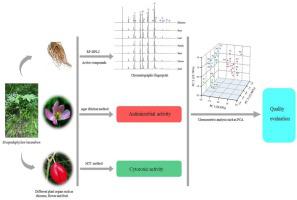Industrial Crops and Products ( IF 5.6 ) Pub Date : 2021-10-18 , DOI: 10.1016/j.indcrop.2021.114159 Wei Liu 1 , Dong-xue Yin 2 , Nan Tang 3 , Tong Zhang 1 , Jia Wang 1 , De-hua Qin 1 , Zheng Zhang 1

|
Sinopodophyllum hexandrum (Royle) Ying is a perennial medicinal plant that produces the anti-cancer lignan compositions especially podophyllotoxin. Since podophyllotoxin commercial production via chemical synthesis, biotechnological intervention or cultivation has yet to meet the increasing demand, mining the potentially available plant organs to discover more natural podophyllotoxin sources is essential. This study investigated the reversed-phase high performance liquid chromatography (RP-HPLC) fingerprint, active chemicals (lignans, flavonoids, and phenolic profiles), and bioactivities (antimicrobial and cytotoxic activities) of distinct S. hexandrum plant organs. Among different plant organs, the rhizome is a preponderant organ due to high active compounds especially podophyllotoxin at 71.615☓103 μg/mL, high bioactivity with low minimum inhibitory concentration (MIC)/minimal bactericidal concentration (MBC)/minimal fungicidal concentration (MFC) value of 5/5/5 mg/mL, and low CIR50 value of 0.0718 μg/mL, followed by root. Chemometrics analysis techniques, including correlation analysis (CA), similarity analysis (SA), hierarchical cluster analysis (HCA), principal component analysis (PCA), and discriminant analysis (DA), were further employed to facilitate accurate quality assessment of different plant organs from S. hexandrum. The findings unambiguously validated the clustering of seven samples into four major groups (G1–G4), with G1 (rhizome)>G2 (root)>G4 (fruit, blossom, and leaf)>G3 (stem and petiole) as the consistent quality ordering, despite significant differences in chemical compositions and bioactivities. Considered the practical application, the rhizome is, therefore, a preferred medicinal organ, and root could be considered as a substitute resource. The rhizome or root extraction could be used as a potential raw material source for natural antimicrobial agents and cancer cell inhibitors in the food, medicine, and healthcare industries. This research added to our understanding of the integrated exploitation and utilization extension of S. hexandrum resources. RP-HPLC fingerprinting in combination with chemometrics approaches was also confirmed as a highly reliable method for assessing the quality of S. hexandrum and other industrial crops.
中文翻译:

基于活性成分、生物活性和反相高效液相色谱指纹图谱的中华鬼臼(Royle) Ying质量评价
中华鬼臼(Royle) Ying 是一种多年生药用植物,可产生抗癌木脂素成分,特别是鬼臼毒素。由于通过化学合成、生物技术干预或栽培进行的鬼臼毒素商业生产尚未满足日益增长的需求,因此挖掘潜在可用的植物器官以发现更多天然鬼臼毒素来源至关重要。本研究调查了不同S. hexandrum的反相高效液相色谱 (RP-HPLC) 指纹、活性化学物质(木脂素、类黄酮和酚类成分)和生物活性(抗菌和细胞毒活性)植物器官。在不同的植物器官中,根茎是一种优势器官,因为其高活性化合物特别是鬼臼毒素71.615☓10 3 μg/mL,生物活性高,最低抑菌浓度(MIC)/最低杀菌浓度(MBC)/最低杀菌浓度(MFC)低) 5/5/5 mg/mL 的值,以及 0.0718 μg/mL 的低 C IR50值,其次是根。进一步采用化学计量学分析技术,包括相关分析(CA)、相似性分析(SA)、层次聚类分析(HCA)、主成分分析(PCA)和判别分析(DA),以促进对不同植物器官的准确质量评估来自S. hexandrum. 研究结果明确验证了将七个样本分为四个主要组 (G1–G4),其中 G1(根茎)>G2(根)>G4(果实、花朵和叶)>G3(茎和叶柄)作为一致质量尽管化学成分和生物活性存在显着差异,但排序。考虑到实际应用,根茎是首选的药用器官,根可作为替代资源。根茎或根提取物可用作食品、医药和保健行业中天然抗菌剂和癌细胞抑制剂的潜在原料来源。这项研究增加了我们对六味子综合开发利用延伸的理解资源。RP-HPLC 指纹图谱结合化学计量学方法也被证实是一种非常可靠的方法,用于评估S. hexandrum和其他经济作物的质量。











































 京公网安备 11010802027423号
京公网安备 11010802027423号